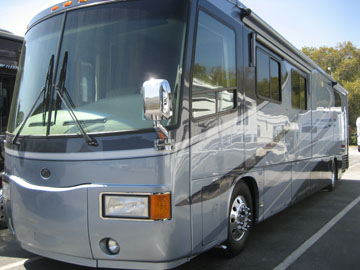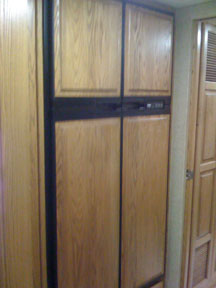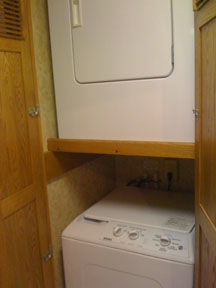Buying the "Moose"
Early March
Tuesday March 10
Found a motor home at Lazy Days in Tampa that we liked (a 40-foot diesel pusher, meaning the diesel engine is in the rear) made by Travel Supreme. It is a pretty steel blue color that changes a lot based on the light. Five years old, but only 13,000 miles. It looked as if they never cooked in it — the cook top and microwave/convection oven looked untouched.

The only thing that didn’t work was the cover for the step well when you travel, so the passenger doesn’t fall down into the step well leading to the outside. It came with a couch that made into a queen bed. We wanted more comfort so we had them take that out and we replaced it with a Lazy-Boy chair. It also had an electric fireplace (ugly) that we asked them to remove and replace with storage.
Thursday March 19
Returned to Tampa to “close” on the home. We got a walk through of all the systems, which I captured on videotape so we could review it later if we needed to. Ken drove our new Moose to Sun ‘N Fun in Sarasota. I followed with the car. When I got there, the police were just leaving. You can read about that on the March 20posting.
Skip this if you don’t want to hear about how motor homes work
If you’re not familiar with RVs you may not know how complex they are. For example, there are three ways you can get water into the home. First, when you’re on the road, you have an in-house water tank and a pump that furnishes water to the sinks and toilet. When hooked up, you can either hook up the city water to the inside, or hook the water up to what is the “black” holding tank, to rinse it out. (You can probably already see what dangers lie ahead. Hook up to the black tank, overfill it and you have an awful mess, i.e. flood in the house.) You may wonder how we know that. That’s because during our walk through the fellow told us the wrong place to hook up outside water, and on our first night we flooded the home with water from the biffy. (Yes, I checked the videotape and he had it wrong.) Had to get a carpet cleaner out to remove the water, clean the carpet and disinfect the floors. That was our mistake number one.
Another system has to do with electricity. On the road the lights, toilet pump, water pump to the sinks etc. works off coach batteries. There is air conditioning for the driver and passenger in the dash as you travel. However, if you want to add air conditioning throughout the coach, you turn on the generator and it will run everything. At the site and hooked in, you may have the choice of 20, 30, or 50 amps. If you want both air conditioners to work (one front, one rear), you need 50 amps. First night after the water fiasco, we couldn’t get the electric to work at all. Mind you, this is our fourth RV, with the last one being sold in 1992 — a long time ago for our fading memories. A neighbor at the site gently suggested we might want to turn on the circuit breakers at the outside source. We did, and voila! Electricity everywhere.
The refrigerator is also interesting. On the road it runs off the coach batteries. Parked with no electric it turns to LP gas. And hooked up it runs from the 50-amp circuit plugged in. Everyone hopes there isn’t a glitch and that it makes these automatic switches correctly, otherwise you get defrosted without wanting it. We have a four-door frig. Two doors open the main refrigerator. One above is freezer only. The other is an icemaker and extra freezer space.
 |
 |
Our other luxury item is a separate washer and dryer. The dryer runs on 110 (there is no 220 to the motor home), so it just takes longer than it does for you guys.